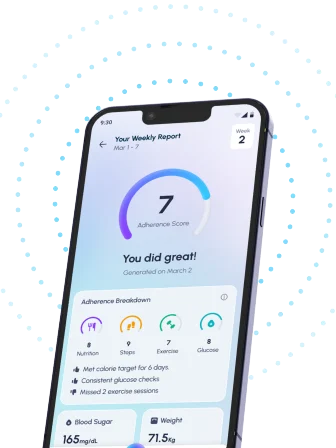Table of Contents
- Understanding Dehydration in Diabetes: A Complete Guide
- Diabetes & Dehydration: Recognizing the Warning Signs
- What Causes Dehydration in People with Diabetes?
- Preventing Dehydration: Tips for Diabetics
- Is Your Thirst a Diabetes Symptom? Dehydration Risks
- Frequently Asked Questions
- References
Feeling excessively thirsty, constantly tired, or urinating more frequently than usual? These could be subtle signs of something more serious. This blog post tackles the crucial connection between Diabetes and Dehydration: Recognizing the Symptoms and Underlying Causes is key to managing both conditions effectively. We’ll explore how diabetes impacts your body’s fluid balance, leading to dehydration, and delve into the specific symptoms you should watch out for. Understanding this relationship is vital for preventing serious complications and improving your overall health.
Understanding Dehydration in Diabetes: A Complete Guide
Diabetes significantly increases your risk of dehydration, a serious complication that can worsen existing health problems. In hot and humid climates prevalent in many Indian and tropical countries, this risk is amplified. The elevated blood sugar levels characteristic of diabetes affect kidney function, leading to increased urination and fluid loss. This is further exacerbated by conditions like diabetic ketoacidosis (DKA) which can cause severe dehydration. Nearly 30% of people with diabetes develop diabetic nephropathy (kidney disease), highlighting the critical link between diabetes management and hydration.
Recognizing the Symptoms
Dehydration symptoms in individuals with diabetes can be subtle and easily mistaken for other diabetic complications. Look out for excessive thirst (polydipsia), dry mouth, infrequent urination (despite high blood sugar), fatigue, dizziness, and dark-colored urine. In severe cases, you might experience confusion, rapid heartbeat, and low blood pressure. Recognizing these symptoms early is crucial for preventing serious health consequences.
Underlying Causes and Prevention
The underlying causes are multifaceted, stemming from the physiological effects of diabetes itself. The increased urination (polyuria) characteristic of diabetes leads to significant fluid loss. Furthermore, the frequent use of certain diabetic medications, such as diuretics, can also contribute to dehydration. In tropical climates, factors like increased sweating due to heat and humidity further compound the problem. Maintaining proper hydration is paramount. Increase your fluid intake, especially water, and consume hydrating fruits and vegetables. Regular monitoring of blood sugar levels is also essential for managing diabetes and reducing the risk of complications. Understanding how diabetes affects your overall health, including your blood flow, is also important. You can learn more by reading our article on How Does Diabetes Affect Blood Flow?
Actionable Steps for Indian & Tropical Climates
In hot and humid regions like India, proactive measures are vital. Carry a water bottle and sip water regularly throughout the day, even if you don’t feel thirsty. Consume hydrating beverages like coconut water (naturally rich in electrolytes) and homemade ORS solutions to replenish lost electrolytes. Consult your doctor or a registered dietitian to create a personalized hydration plan that considers your specific needs and climate. Prioritizing hydration can significantly improve your overall health and well-being. As you age, managing diabetes presents unique challenges. For helpful advice and strategies, check out our guide on Managing Diabetes as You Age: Challenges and Solutions.
Diabetes & Dehydration: Recognizing the Warning Signs
Diabetes and dehydration are a dangerous combination, particularly prevalent in hot and humid climates like those found across India and other tropical countries. The alarming statistic that 50% of diabetes cases worldwide are undiagnosed according to the IDF Diabetes Atlas highlights the urgent need for increased awareness, especially in regions where high temperatures exacerbate the risks. Dehydration can worsen existing diabetic complications and mask symptoms, making early detection even more challenging.
Recognizing the Signs of Dehydration in Diabetics
Typical dehydration symptoms—such as extreme thirst, dry mouth, and decreased urination—can be easily mistaken for common diabetes symptoms. However, in diabetics, dehydration can manifest more severely. Look out for excessive fatigue, dizziness, confusion, and rapid heartbeat, which can indicate a serious drop in blood volume. In tropical climates, these symptoms can develop rapidly due to increased perspiration and fluid loss. Sunstroke is another serious risk to consider, particularly for individuals with poorly managed diabetes. Early detection is key, and knowing the 10 Early Signs and Symptoms of Diabetes? can be crucial in preventing serious complications.
Understanding the Underlying Causes
High blood sugar levels in diabetes can lead to increased urination (polyuria), resulting in significant fluid loss. This is compounded by the increased thirst (polydipsia) often experienced by diabetics, which, if not properly addressed, leads to dehydration. The combination of heat, sweat, and increased urination makes individuals with diabetes in tropical regions especially vulnerable. Understanding the connection between diabetes and other health factors, such as Understanding the Link Between Diabetes and Obesity, can also help in managing the risk of dehydration.
Taking Action
Regular monitoring of blood sugar levels and hydration is crucial. Pay attention to your body’s signals. If you experience any of the above symptoms, seek medical attention promptly. Staying hydrated is especially important in hot and humid climates. Drink plenty of water throughout the day, even if you don’t feel thirsty. Consider carrying a water bottle and refilling it regularly, especially when spending time outdoors. In India and other tropical countries, proactive measures are key to preventing serious health complications from this often overlooked combination.
What Causes Dehydration in People with Diabetes?
Dehydration is a serious concern, especially for individuals with diabetes, particularly in hot and humid climates like those prevalent in India and other tropical countries. The link between diabetes and dehydration isn’t always immediately apparent, but understanding the underlying causes is crucial for effective management. One significant factor is the increased urination often experienced by people with diabetes, a consequence of high blood sugar levels. The body tries to flush out excess glucose through increased urination, leading to fluid loss.
Frequent Urination and Polydipsia
This frequent urination, medically termed polyuria, is often accompanied by increased thirst (polydipsia). While seemingly straightforward, this increased thirst can be easily overlooked, especially in busy daily routines. Individuals may not always adequately replenish fluids lost through urination, contributing to dehydration. This is further complicated by the fact that over 60% of people with diabetes in India also have hypertension, a condition that can exacerbate fluid imbalances. Hypertension often requires medication which can also contribute to dehydration as a side effect.
Medication Side Effects
Certain diabetes medications can also increase the risk of dehydration. Always consult your doctor or pharmacist about potential side effects, including dehydration, and discuss strategies for managing fluid intake. Paying close attention to your body’s signals, such as feeling thirsty or experiencing dizziness, is vital. The increased thirst can be related to the feeling of constant hunger, as explained in our article on Why Does Diabetes Make You Hungry?
Practical Tips for Hydration
Staying adequately hydrated is paramount for managing diabetes effectively, especially in tropical climates. Keep a water bottle handy, and sip water throughout the day. Include hydrating foods like fruits and vegetables in your diet. Regularly monitor your urine color – dark yellow indicates dehydration, while pale yellow suggests adequate hydration. In cases of severe dehydration, seek immediate medical attention. Proactive hydration strategies can significantly improve your overall health and well-being. Understanding the connection between diabetes and other health complications, such as those affecting the respiratory system, is also crucial. For more information, read our article on How Does Diabetes Affect the Respiratory System?
Preventing Dehydration: Tips for Diabetics
Staying Hydrated in Hot Climates
Diabetes can increase your risk of dehydration, especially in hot and humid Indian and tropical climates. High blood sugar levels can lead to increased urination, further depleting your body’s fluid reserves. This is exacerbated by factors common in these regions, such as intense heat and strenuous physical activity. Remember, maintaining proper hydration is crucial for managing your diabetes effectively.
Practical Hydration Strategies
Always carry a water bottle and sip water regularly throughout the day, even if you don’t feel thirsty. Aim to drink at least 8 glasses of water daily, adjusting this based on your activity level and climate. Incorporating hydrating foods like watermelon, cucumber, and coconut water into your diet can also help. Remember, while 45–60 grams of carbs per meal are often suggested for diabetes management, proper hydration plays a vital role in absorbing and utilizing those carbohydrates. Managing your carbohydrate intake is also key to preventing long-term complications, as highlighted in How to Prevent Long-Term Complications of Diabetes: Easy Tips.
Monitoring and Seeking Help
Pay close attention to your urine color; dark yellow urine signifies dehydration. If you experience symptoms like dizziness, fatigue, or rapid heartbeat, seek medical attention immediately. Consult your doctor or a certified diabetes educator for personalized hydration strategies, particularly if you live in a region with consistently high temperatures. They can guide you on the best approach for your specific needs and dietary plan, ensuring you stay adequately hydrated and manage your diabetes effectively. Don’t hesitate to reach out for support – your health is paramount. Proper hydration is just one piece of the puzzle; protecting your heart is equally important. Learn more in Protect Your Heart from Diabetes: 5 Essential Steps.
Is Your Thirst a Diabetes Symptom? Dehydration Risks
Understanding the Link Between Diabetes and Dehydration
Excessive thirst, or polydipsia, is a common symptom of both type 1 and type 2 diabetes. This isn’t just about feeling thirsty; it’s often a significant and persistent symptom. The underlying cause is related to how your body handles glucose. When your blood sugar levels are high, your kidneys work overtime to filter out the excess glucose, resulting in increased urination. This leads to significant fluid loss and, consequently, dehydration. The constant need to urinate leaves you feeling parched and needing to drink frequently. This is especially crucial in hot and humid Indian and tropical climates where dehydration risk is already heightened.
Dehydration’s Impact in Tropical Climates
Dehydration, exacerbated by high blood sugar, poses a serious threat in regions like India and other tropical countries. The intense heat and humidity can accelerate fluid loss, making individuals with diabetes even more vulnerable to complications like diabetic ketoacidosis (DKA) or hyperosmolar hyperglycemic state (HHS), both of which are life-threatening. The increased risk of dehydration is further compounded by common practices in many tropical regions, such as consuming large amounts of sugary drinks. Research shows that daily consumption of sugary beverages raises diabetes risk by 26%, directly contributing to the cycle of high blood sugar, frequent urination, and dehydration. This constant state of dehydration can also contribute to other symptoms, such as the fatigue described in our article, Does Diabetes Make You Tired? – Tap Health.
Practical Steps to Prevent Dehydration
Staying adequately hydrated is paramount for managing diabetes, especially in tropical climates. Carry a water bottle and sip water regularly throughout the day. Choose hydrating, non-sugary beverages like coconut water (popular in many tropical regions) or herbal teas. Limit consumption of sugary drinks and caffeinated beverages. Monitor your urine output; dark yellow urine suggests dehydration, while pale yellow urine indicates adequate hydration. If you experience excessive thirst or frequent urination, consult your doctor immediately. Early detection and management are key to mitigating the risks of dehydration and its complications associated with diabetes. It’s also important to be aware of other potential symptoms, such as those discussed in Can Diabetes Cause Loss of Taste and Smell?.
Frequently Asked Questions on Diabetes and Dehydration
Q1. How does diabetes increase my risk of dehydration?
Diabetes often leads to increased urination due to high blood sugar, causing fluid loss. This is worsened by conditions like diabetic ketoacidosis and some medications.
Q2. What are the symptoms of dehydration in people with diabetes?
Symptoms include excessive thirst, dry mouth, infrequent urination, fatigue, dizziness, and dark urine. Severe dehydration can cause confusion, rapid heartbeat, and low blood pressure. These can be easily confused with other diabetic complications.
Q3. How can I prevent dehydration if I have diabetes?
Drink plenty of water, eat hydrating foods, and monitor your blood sugar regularly. In hot climates, carry water and consider electrolyte drinks. A personalized hydration plan from your doctor is recommended, especially if you also have hypertension.
Q4. What should I do if I suspect I’m dehydrated?
If you experience several dehydration symptoms, contact your doctor immediately. Early detection and treatment are crucial to prevent serious health consequences.
Q5. Why is a personalized hydration plan important for people with diabetes?
A personalized plan accounts for individual needs and medications, which can affect hydration. Your doctor can help you determine the right amount of fluid intake for your specific situation and health conditions.
References
- A Practical Guide to Integrated Type 2 Diabetes Care: https://www.hse.ie/eng/services/list/2/primarycare/east-coast-diabetes-service/management-of-type-2-diabetes/diabetes-and-pregnancy/icgp-guide-to-integrated-type-2.pdf
- Diabetes Mellitus: Understanding the Disease, Its Diagnosis, and Management Strategies in Present Scenario: https://www.ajol.info/index.php/ajbr/article/view/283152/266731




